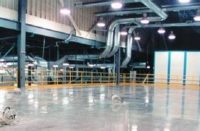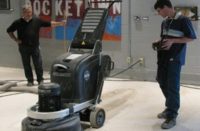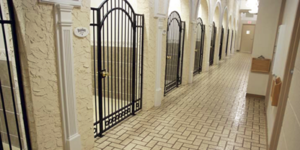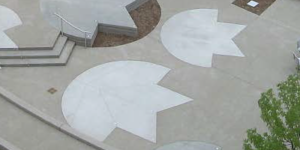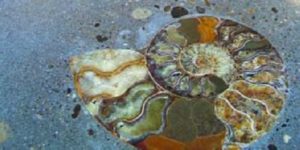|
|
|
Bart Rockett, 46, began working with concrete back in 1987 after joining Patterned Concrete Industries (PCI) and working for one of its local franchises outside of Philadelphia in southern New Jersey. That’s where he was introduced to the world of stamped concrete.
A Philadelphia native, Rockett began working with concrete right out of high school. As a student interested in art, though, basements and footings had little appeal. “That wasn’t for me,” he says. “I was supposed to go to art school in college and had some other opportunities come up and decided to get involved with a trade instead. I stumbled upon patterned concrete which was pretty cool for 1988.”
Working with the greats
PCI was a national franchise offering annual training for its members. “We learned from the best guys in the world, the likes of Mike Archambault and Ralph Gasser,” he says. “These were founders of this company — who are now in the Decorative Concrete Hall of Fame — that I trained under coming up through the ranks of patterned concrete.”
|
|
|
|
The Walt Disney people chose PCI to do all the work for their theme parks, Rockett says. The guys who developed these techniques for Disney were teaching the trainings once a year to the franchisees and Rockett soaked up the education with the intention of getting as much out of it as possible. “That was my college education,” he says, “because I figured if I’m working with a guy who did all the work at Disney and he’s going to take me by his side and show me all the tricks, I’m going to take that and learn all I can from what they’re teaching me.”
|
|
|
|
After working for PCI for nine years, in the mid-’90s Rockett went out on his own because his boss, he says, “wasn’t expanding on the new technologies that I wanted to explore — the etching, acid staining and other creativity. He was running it like a business which you have to do, but you also have to create things.”
Rockett enjoys the creative process so much that he scarcely considers what he does to be work. “It’s fun for me,” he says. “It’s not a job because I enjoy it. It’s passion driven.”
Loving the challenges
Consistently challenging himself by taking on the most complex jobs that no one else wanted, Rockett mastered both simple and difficult tasks and built a polished — no pun intended — resume for himself. Now, his clients trust him to do optimal work on all of his jobs. “You’ve got to take chances or you’ll never expand your horizons,” he explains. “Yeah, there were failures, but you better learn from them and do it better next time. Keep it small and always do really good work and you’ll always be busy.”
Enjoying the winning streak
With more than 2 million square feet of personally stamped concrete to his credit, Rockett believes he’s stamped enough to now move on to bigger and better things. In recent years, he’s developed a new technique that’s in high demand in his urban area of the country. This technique involves etching polished concrete into the shape of large tiles and adding color details with L. M. Scofield stains.
|
|
|
|
“We’re becoming one of the leaders on the East Coast of innovating different looks in polished concrete,” Rockett says. “Now, owners give us carte blanche to do what we want.”
Architects are consistently “blown away” by his floors, he says, and he’s won six Scofield awards, two American Concrete Institute New Jersey awards and two Hanley Wood awards. He’s successfully done numerous high-end private residences and 10,000 square feet for the Yankees’ PNC Field. He’s worked on New York City’s first green building built for the parks department, as well as the city’s new Alexandria Center for Life Science building. In September, Rockett worked on a restaurant for world-famous chef Masaharu Morimoto.
Eyeing the future
Next up, Philadelphia Polished Concrete will tackle an Indian motorcycle dealership in Lebanon, New Jersey, with plans to use two different colors along with integral color. “We’ll be grinding it so it looks like terrazzo, stamping about a 12-foot oval in the front entrance and then sand-blasting and etching their logo into the stamped circle and then polishing around it in two different colors,” Rockett says.
|
|
|
|
|
|
He’s also investing in a 2,200-square-foot showroom near Long Beach, New Jersey, about 45 minutes from New York City, displaying samples of his polished, vertical, stamping and countertop work. “People like to see what they’re getting,” he says. “I can show architects pictures all day long but when they see a couple hundred square feet of each thing, that’s when they really get it. The flooring that we’re doing is a lot more detail-oriented than your typical guy doing a polished concrete job, so I want to bring people to the showroom so they can see all the colors and everything that can be done.”
With the polished concrete market “exploding” in his neck of the woods, Rockett says he must set himself apart from the competition, which he contends the strength of his work and the new showroom will do in no uncertain terms.
|
|
|
|
|
|
“With these polished concrete floors being as beautiful and as time-consuming to produce as they are, we want the people to come in and see it and touch it,” he says. “We like to do challenging, colorful, off-the-charts work and push the limits.”
www.philadelphiapolishedconcrete.com
